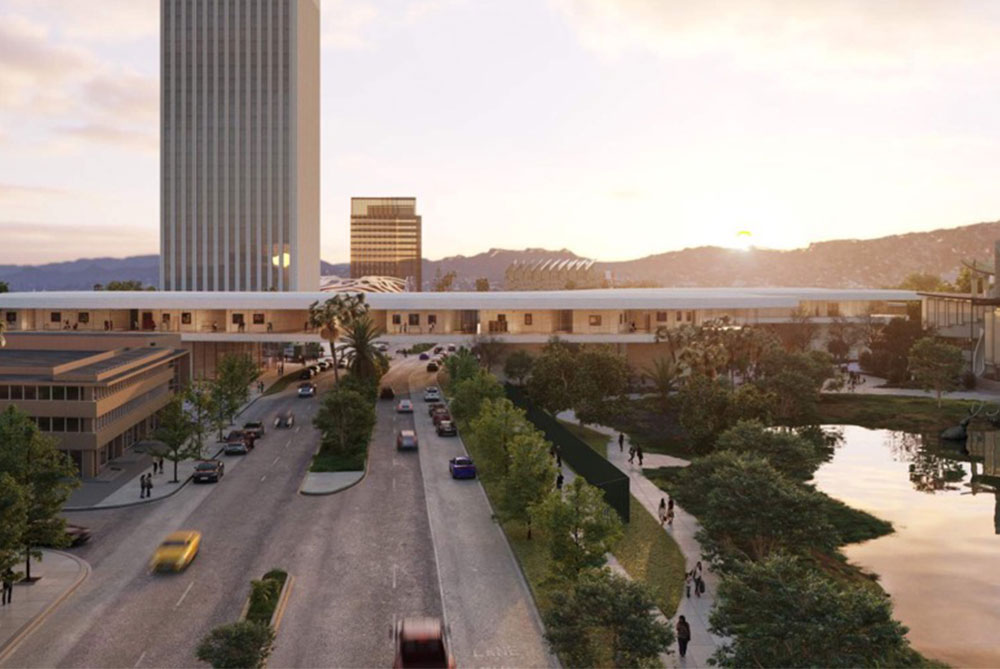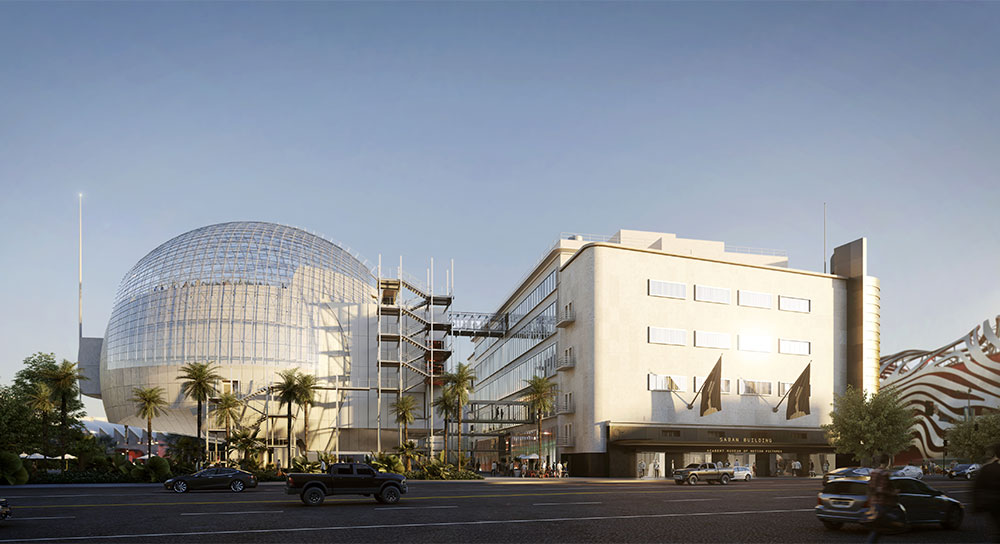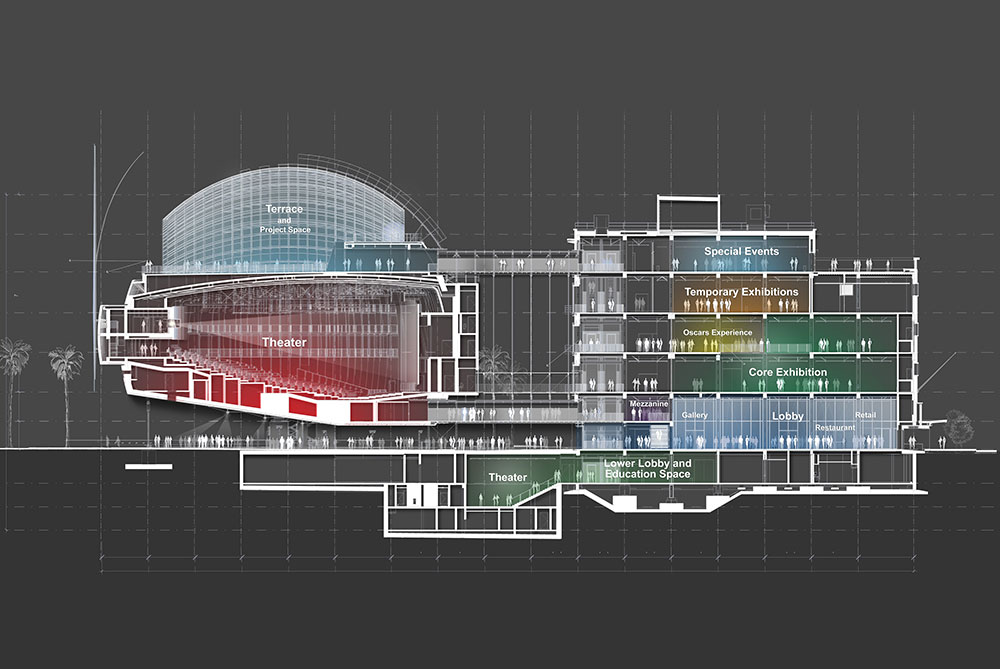Major investments and sublime starchitecture could finally fortify California as a global arts hub
Words by PETER DAVIS
Illustration by NEIL WEBB
Watch out New York, London and Paris: California is in the middle of an all-out billion-dollar culture awakening. Now the fifth-biggest economy in the world, its technology and entertainment industries are experiencing unprecedented profits, which means lots of deep-pocketed patrons are funding the arts in a very big way.
The new contemporary gallery at the HAMMER MUSEUM.
In L.A., the Hammer Museum is adding a whopping 40,000 square feet of gallery space, and the big guns at La Brea Tar Pits and the surrounding 12-acre site are currently deciding among three fresh new looks to go for. Meanwhile, some major museums and institutions are opting to start from the ground up. We take a closer look at how the Orange County Museum of Art (OCMA), Los Angeles County Museum of Art (LACMA) and the Academy Museum of Motion Pictures have enlisted high-profile, Pritzker Prize-winning starchitects to help write the next chapter in California’s cultural history.
OCMA is moving from Newport Beach to the Segerstrom Center for the Arts in Costa Mesa. Designed by Thom Mayne and his firm, Morphosis, the new three-story, 52,000-square-foot building has been more than 10 years in the making. The South Coast Plaza-owning Segerstrom family deeded the land to the museum in 2008, and it is slated to open in 2021. The museum, which has long championed emerging artists in the Pacific Rim, conducted an exhaustive international search for an architect before deciding on L.A.-based Mayne.
“We were struck by Mayne’s dedication to creating a Southern California vernacular that understood the nature of the region, his consistent pursuit of innovative ways to incorporate architecture into an existing environment, and his experimentation with materials and forms,” explains OCMA’s director and chief executive, Todd Smith.
The new OCMA boasts a futuristic yet organic facade: imagine the most stylish spaceship landing in the middle of Orange County. The undulating bands of metal panels will house a reconfigurable exhibit space, a multiuse education hall, a rooftop sculpture terrace and storefront galleries with one section of exhibit space viewable from the street, aptly named Avenue of the Arts. The piece de resistance? A massive outdoor staircase that swerves toward the museum’s entrance near Richard Serra’s Connector sculpture, which commands the Segerstrom Center’s Julianne and George Argyros Plaza, a gathering place for the public, much like the stairs outside the Metropolitan Museum of Art in New York.
With more than double the exhibition space of the Newport Beach location, OCMA will get to show off its impressive permanent collection of over 3,500 pieces, including seminal works by Chris Burden, Edward Ruscha, Catherine Opie and John Baldessari, to name just a few.
“I don’t think there will be another museum experience like it on this scale”
MICHAEL GOVAN, LACMA DIRECTOR
Megamogul David Geffen just donated $150 million to kickstart LACMA’s new building designed by Swiss architect Peter Zumthor. With an overall budget of $650 million, LACMA is replacing its four aging buildings with one nearly 350,000-square-foot structure. Featuring a horizontal design and a single-level gallery floor, the space will allow visitors to flow through the exhibits in one continuously fluid high-art journey without ever being disrupted by stairs or elevators.
LACMA’s building was originally black, in a reference to the nearby LA BREA TAR PITS. Photo courtesy Atelier Peter Zumthor/The Boundary.
“You will make your own path through this new LACMA and stumble upon surprises and new discoveries,” enthuses museum director Michael Govan. “I don’t think there will be another museum experience like it on this scale, and people will have to come to L.A. for that.”
This fresh approach is made even more unique with galleries that let in natural light and don’t need controlled artificial lighting to display sensitive works. The concrete gallery walls create an industrial mood, a move away from the whitewashed backgrounds of most museums and galleries. “Zumthor doesn’t have a signature style, but rather responds to a specific location and circumstances,” Govan explains. “His considered, respectful approach to a place was the ideal one to reimagine LACMA’s presence in the center of a busy urban area but located in a park that is known for its Pleistocene-era tar pits.”
The new LACMA will open in 2023 with approximately 110,000 square feet of gallery space, a new theater, three restaurants/cafes and covered multipurpose event spaces, as well as 3.5 acres of new park and open space, becoming a nexus in the city for art on the grandest of scales. “What’s attracting artists … to L.A. is how much art there is everywhere and how it’s presented in so many different ways,” Govan concludes.
Down the street from LACMA, the art of moviemaking’s Academy Museum of Motion Pictures is following suit, now scheduled to open in April 2021. It not only boasts a star-studded Board of Trustees (chair Ron Meyer, Jason Blum, Diane von Furstenberg, to name a few) and Academy Museum Campaign Committee (Bob Iger, Annette Bening, Tom Hanks), it has collected over 2,500 three-dimensional motion picture objects since 2008, from Dorothy’s ruby slippers from The Wizard of Oz to the only surviving shark model from Jaws.
ACADEMY MUSEUM OF MOTION PICTURES.
The museum also draws upon the collection of the Academy of Motion Picture Arts and Sciences’ 12 million photographs, 190,000 film and video assets, 80,000 screenplays, 61,000 posters and 104,000 pieces of production art as well as 1,600 special collections of personal artifacts from film legends like Cary Grant, Katherine Hepburn and Alfred Hitchcock.
The Academy’s selection committee chose Renzo Piano’s architecture firm to reimagine the Saban Building (the former May Company department store) on Wilshire Boulevard, and to add to it an impressive spherical structure. “Renzo drew his inspiration from our site on Miracle Mile with its landmark 1939 Saban Building and from the visionary nature of movie-going itself,” explains Brendan Connell Jr., the museum’s chief operating officer. “He envisioned the beloved Streamline Moderne building, which embodies the spirit of Los Angeles during the golden age of Hollywood, connected to a futuristic spherical structure in a way that would express the experience of film as a voyage through our museum.”
The 300,000-square-foot museum is a film lover’s playground, with a highly immersive permanent exhibition, two film and performance theaters (the 1,000-seat David Geffen Theater and the 288-seat Ted Mann Theater), and an education studio. The museum is set to open in 2020 with an inaugural show in collaboration with Studio Ghibli and devoted to Hayao Miyazaki — the first major retrospective of his work in the U.S., followed by a thematic exhibition called “Regeneration: Black Cinema 1900-1970,” an unprecedented survey of African American contributions to cinema before blaxploitation.
ACADEMY MUSEUM OF MOTION PICTURES.
“The exhibitions will immerse visitors in manifold and diverse stories by integrating rare and remarkable objects from the museum’s collection and multiscreen film projections into a setting with evocative decor and lighting,” explains Doris Berger, acting head of curatorial affairs. Although building the 1,500-paneled sphere has come with its fair share of delays, it will be well worth the wait.
This story originally appeared in the October 2019 issue of C Magazine and has been updated as of July 1, 2020.
Discover more CULTURE news.







